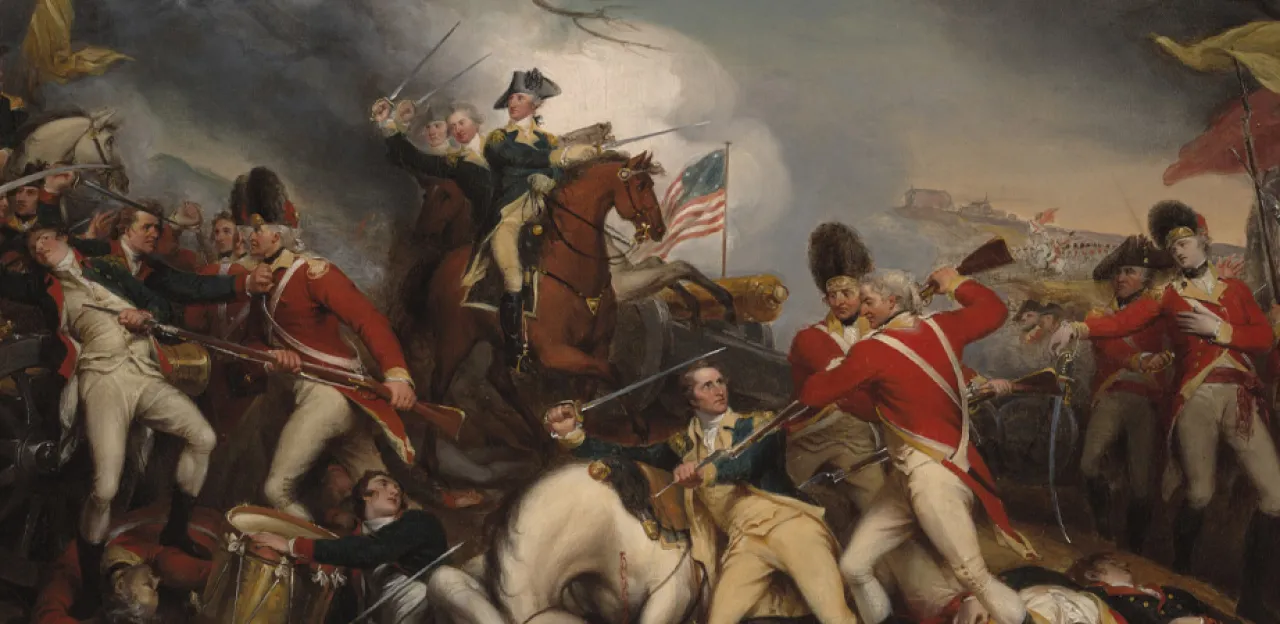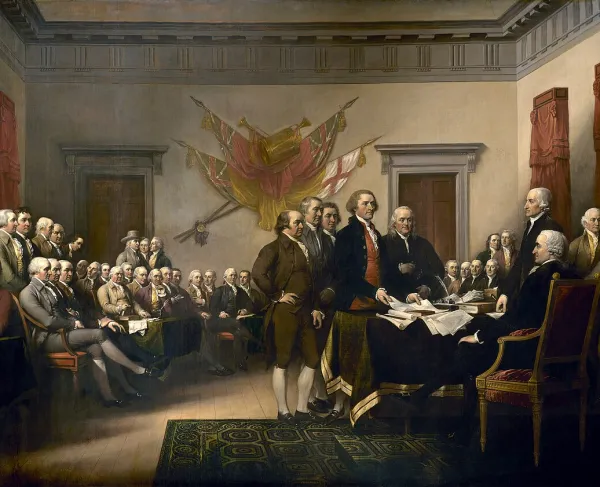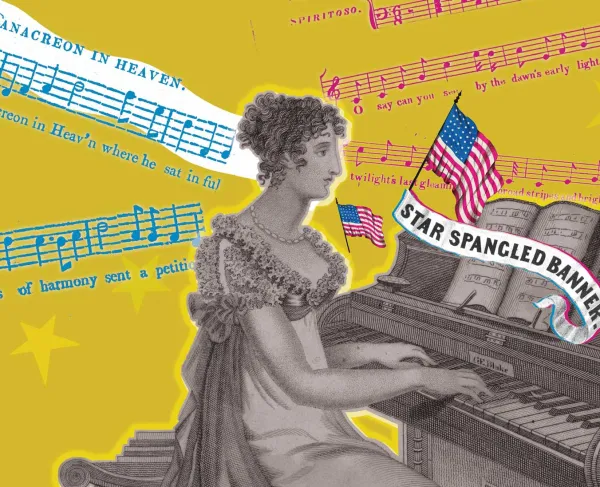A Teacher's Guide to Revolutionary War Movies

Disclaimer: Every single one of these films or television shows is ultimately made for entertainment rather than education. For this reason, one should not expect them to adhere to total historical accuracy at all times, though they can be incredibly useful for showing how American society during different periods dealt with the legacy of the conflict. That said, we strongly recommend that teachers watch each title on their own and make their own judgements on what is appropriate or useful for their classrooms.
1776 (1972): Based on the Tony Award-winning musical, 1776 revolves around the Second Continental Congress and the decision on whether to declare independence from Great Britain. While currently overshadowed by Hamilton as far as Revolutionary War musicals go, 1776, which features some of America’s more famous Founding Fathers like Adams, Jefferson and Franklin, is a light-hearted yet thoughtful show in its own right. Much of the song lyrics are actually taken right from the words of the Founding Fathers themselves, sometimes from their own private journals about the events, though it does get a few historic details wrong. The film is rated G, and is appropriate for grades 6-12.
America (1924): A silent film by the famous director D.W. Griffith tells the story of the American Revolution adapted from a Robert W. Chambers novel about the battles and campaigns in New York State. With a running time of over two hours, it may not be feasible to show the whole film in one sitting to a class. The film is unrated, and should be appropriate for audiences in grades 8-12.
Turn: Washington’s Spies (2014 – 2017): A television series on AMC that deals with the creation of the Culper Ring, a group of spies serving George Washington out of New York and Connecticut from 1776 – 1781. As a television series, it is not recommended to show the entire storyline in one sitting. It should be appropriate for grades 9-12.
The Crossing (2000): An A&E made-for-TV-movie featuring Jeff Daniels as George Washington, as he struggles to keep his army together during the Crossing of the Delaware and subsequent Battle of Trenton. The film may have a few historical inaccuracies, notably its claim that Washington suffered no casualties during the Crossing and Battle (he suffered six) as well as a scene where Washington holds Horatio Gates at gunpoint before dismissing him from the army. Winner of the Peabody Award for Excellence in 2000. Runtime is only 89 minutes long. The film is unrated and should be considered appropriate for grades 7-12.
The Revolution (2006): A 13-part History Channel mini-series that combines live action sequences with noted historians as talking heads. This series walks viewers through the causations of the American Revolution to ultimate victory, and liberty. The film is unrated and should be considered appropriate for grades 7-12.
The Scarlet Coat (1955): A historical drama film centered around Cornel Wilde as Major John Bolton, a fictionalized portrayal of historical Continental Army officer and spy master Benjamin Tallmadge. Working undercover in the British Army, Bolton accidentally strikes up a friendship with Major John André before discovering his plans to sabotage the defenses of West Point. The film runs just under two hours and is appropriate for grades 7-12.
John Adams (2008): The HBO miniseries based on the 2001 biography by David McCollough. The series stars Paul Giamatti as the titular character and deals with his political career and personal life from the Boston Massacre, to life after his presidency. It contains some inaccuracies, but ultimately remains true to the character of Adams, along with his relationship with his wife, Abagail, and with other major figures in the Revolution such as Jefferson, Washington, Franklin and Hamilton. The series received phenomenal reviews upon release and remains highly lauded to this day, winning 4 Golden Globes and 13 Emmy Awards. There are seven episodes, each one running a little over an hour. The series is unrated but does contain some mature scenes and are appropriate for grades 9-12.
The Patriot (2000): Film critic Roger Ebert described The Patriot, perhaps the single most expensive and well-known movie about the Revolutionary War to date, the following way, “It basically wants to be a summer action movie, with a historical gloss. At that, it succeeds.” While certainly fun to watch, The Patriot contains several notable inaccuracies teachers should be aware of. Mel Gibson’s leading role of Benjamin Martin is a composite character of figures like Francis Marion, Andrew Pickens and Daniel Morgan, while his opposite, Jason Isaacs as the cartoonishly vile Colonel Tavington, is a fairly obvious proxy for the real British dragoon colonel Banastre Tarleton. While Tarleton did gain a reputation for aggressiveness and brutality during the Southern Campaign, the film exaggerates this to the extreme, including an entirely fictional church burning scene. On the other hand, Martin’s ability to engage in both guerilla and conventional warfare is at least broadly accurate for this period of the war, but it was not just the Americans who did so, as the film applies. The film is rated R for “strong war violence” and is appropriate for grades 8-12.
Drums Along the Mohawk (1939): A married couple (played by Henry Fonda and Claudette Colbert) leaves their comfortable lives in Albany to settle in the frontier, only to get swept up in the American Revolution and face the threat of Indian and Tory raids. Made by famed Hollywood director John Ford, Drums Along the Mohawk was well received in its day but not too famous compared to his other work. While the plot is mostly fiction, the setting of the New York frontier is more historically accurate. Raiding by the British-allied Seneca tribes and American loyalists was a common occurrence in these parts, but some viewers have noticed that the British themselves are largely absent from the film. This could have been part of Ford’s unwillingness to portray a British villain in the lead-up to World War II. The film is unrated and is appropriate for grades 7-12.
John Paul Jones (1959): In this biographical drama, Robert Stack plays the titular naval captain from his early life in Scotland to his death in France after serving in the Russian Imperial Navy. The film’s chronology is mostly accurate in terms of following his career, though it appears to sanitize the character of the man somewhat. The death of a mutinous crew member in the West Indies, before Jones fled to America to escape arrest, is portrayed as an accident. In reality, Jones most likely intentionally killed him. Much of the plot also revolves around a romance between Jones and a woman named Aimee de Tellison, an illegitimate daughter of King Louis XVI, who appears to be entirely fictional. John Paul Jones runs just over two hours, and is unrated, making it appropriate for grades 7-12.
The Time of Their Lives (1946): While this Abbott and Costello comedy begins in the 1780’s, the majority of the film takes place in the 1940’s, with the famous comedy duo appearing as the ghosts of their past selves. The first act which does take place in 1780 revolves around the defection of Benedict Arnold, and the pair’s implication in that plot does inform the rest of the story. Running time is 82 minutes. The film is unrated and should be appropriate for grades 4-12.
Johnny Tremain (1957): Adapted from the 1943 children’s book of the same name, Johnny Tremain tells the story of an apprenticed silversmith who leaves the trade when he injures his hand, only to fall in with the Sons of Liberty and join the Revolutionary War. The film does make a few common errors about the early years of the Revolutionary War, most notably when Paul Revere cries out “The Redcoats are coming” instead of “the regulars are coming.” The film runs at about 80 minutes and is unrated, but should be suitable for grades 1-8.
Liberty Kids (2013): This animated series brings to life the events of the American Revolution by following the lives of three fictional characters. The film is unrated but should be suitable for grades 1-6.





